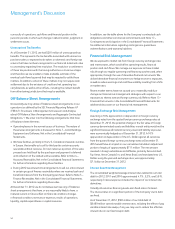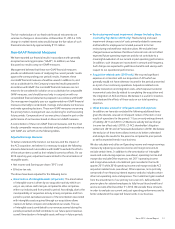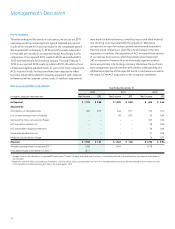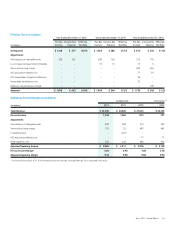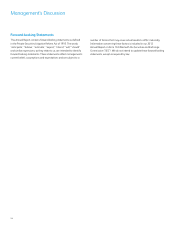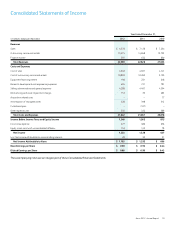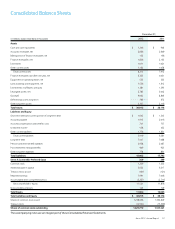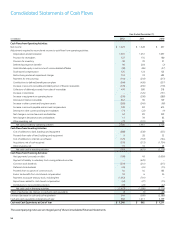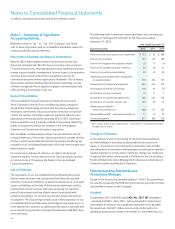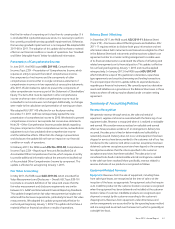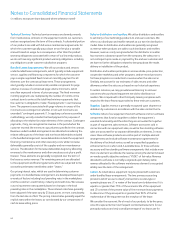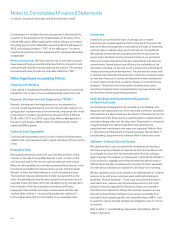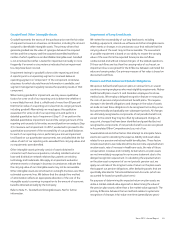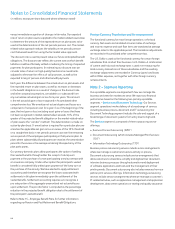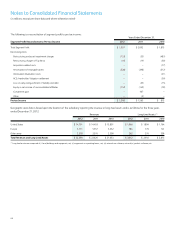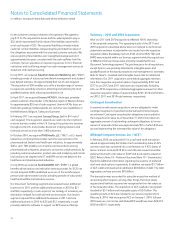Xerox 2012 Annual Report Download - page 62
Download and view the complete annual report
Please find page 62 of the 2012 Xerox annual report below. You can navigate through the pages in the report by either clicking on the pages listed below, or by using the keyword search tool below to find specific information within the annual report.
60
Notes to Consolidated Financial Statements
(in millions, except per-share data and where otherwise noted)
Note 1 – Summary of Significant
Accounting Policies
References herein to “we,” “us,” “our,” the “Company” and “Xerox”
refer to Xerox Corporation and its consolidated subsidiaries unless the
context specifically requires otherwise.
Description of Business and Basis of Presentation
We are a $22.4 billion global enterprise for business process and
document management. We offer business process outsourcing and
IT outsourcing services, including data processing, healthcare solutions,
human resource benefits management, finance support, transportation
solutions and customer relationship management services for
commercial and government organizations worldwide. The Company
also provides extensive leading-edge document technology, services,
software and genuine Xerox supplies for graphic communication and
office printing environments of any size.
Basis of Consolidation
The Consolidated Financial Statements include the accounts of
Xerox Corporation and all of our controlled subsidiary companies.
All significant intercompany accounts and transactions have been
eliminated. Investments in business entities in which we do not have
control, but we have the ability to exercise significant influence over
operating and financial policies (generally 20% to 50% ownership)
are accounted for using the equity method of accounting. Operating
results of acquired businesses are included in the Consolidated
Statements of Income from the date of acquisition.
We consolidate variable interest entities if we are deemed to be the
primary beneficiary of the entity. Operating results for variable interest
entities in which we are determined to be the primary beneficiary are
included in the Consolidated Statements of Income from the date such
determination is made.
For convenience and ease of reference, we refer to the financial
statement caption “Income before Income Taxes and Equity Income”
as “pre-tax income” throughout the Notes to the Consolidated
Financial Statements.
Use of Estimates
The preparation of our Consolidated Financial Statements requires
that we make estimates and assumptions that affect the reported
amounts of assets and liabilities, as well as the disclosure of contingent
assets and liabilities at the date of the financial statements, and the
reported amounts of revenues and expenses during the reporting
period. Future events and their effects cannot be predicted with
certainty; accordingly, our accounting estimates require the exercise
of judgment. The accounting estimates used in the preparation of our
Consolidated Financial Statements will change as new events occur, as
more experience is acquired, as additional information is obtained and
as our operating environment changes. Actual results could differ from
those estimates.
The following table summarizes certain significant costs and expenses
that require management estimates for the three years ended
December 31, 2012:
Year Ended December 31,
Expense/(Income) 2012 2011 2010
Provision for restructuring and asset impairments $ 153 $ 33 $ 483
Provision for receivables 127 154 180
Provisions for litigation and regulatory matters (1) 11 (4)
Provisions for obsolete and excess inventory 30 39 31
Provision for product warranty liability 29 30 33
Depreciation and obsolescence of equipment
on operating leases 279 294 313
Depreciation of buildings and equipment 452 405 379
Amortization of internal use software 116 91 70
Amortization of product software 19 11 7
Amortization of acquired intangible assets 328 401 316
Amortization of customer contract costs 107 49 12
Defined pension benefits –
net periodic benefit cost (1) 300 177 304
Retiree health benefits – net periodic benefit cost 11 14 32
Income tax expense 277 386 256
(1) 2011 includes $107 pre-tax curtailment gain – refer to Note 15 – Employee Benefit Plans
for additional information.
Changes in Estimates
In the ordinary course of accounting for the items discussed above,
we make changes in estimates as appropriate and as we become
aware of circumstances surrounding those estimates. Such changes
and refinements in estimation methodologies are reflected in reported
results of operations in the period in which the changes are made and,
if material, their effects are disclosed in the Notes to the Consolidated
Financial Statements and in Management’s Discussion and Analysis of
Financial Condition and Results of Operation.
New Accounting Standards and
Accounting Changes
Except for the Accounting Standard Updates (“ASUs”) discussed below,
the new ASUs issued by the FASB during the last two years did not have
any significant impact on the Company.
Goodwill:
In September 2011, the FASB issued ASU No. 2011-08, Intangibles
– Goodwill and Other (Topic 350) – Testing Goodwill for Impairment,
which allows an entity to use a qualitative approach to test goodwill
for impairment. ASU 2011-08 permits an entity to first perform a
qualitative assessment to determine whether it is more likely than not


